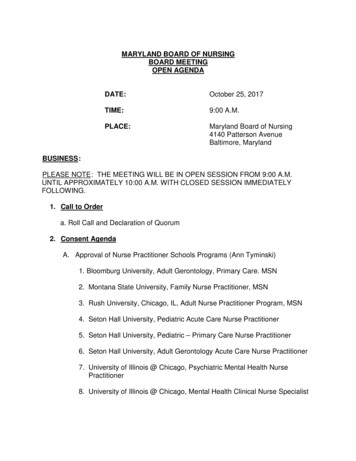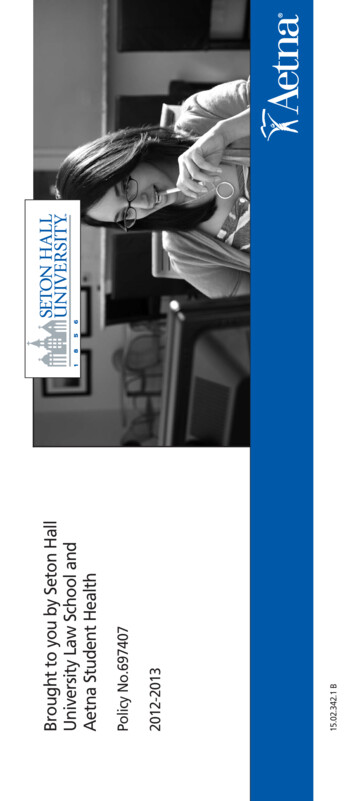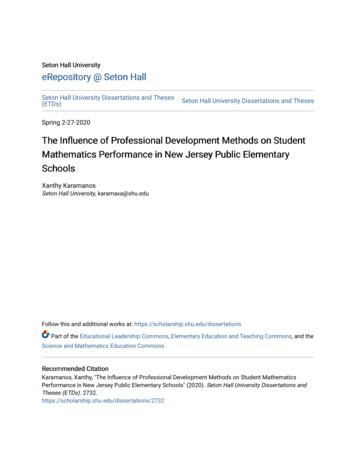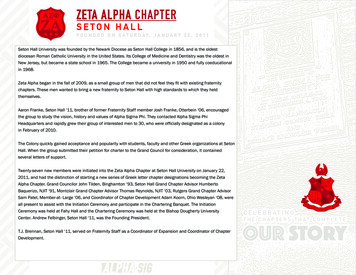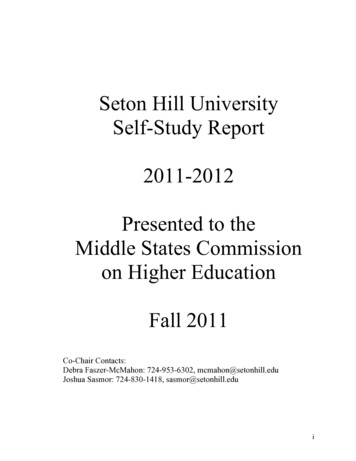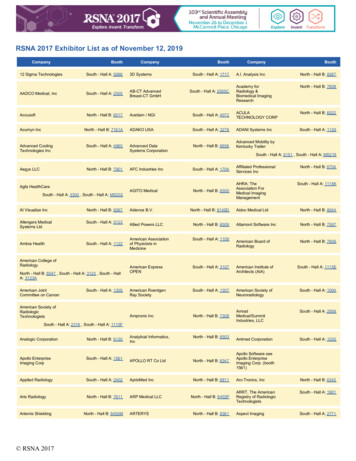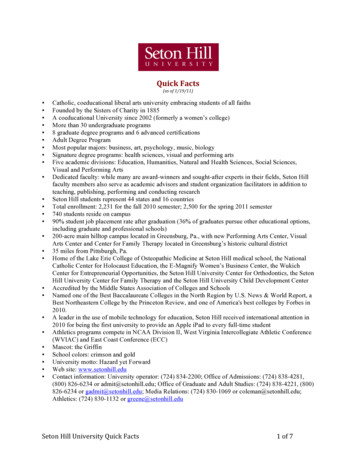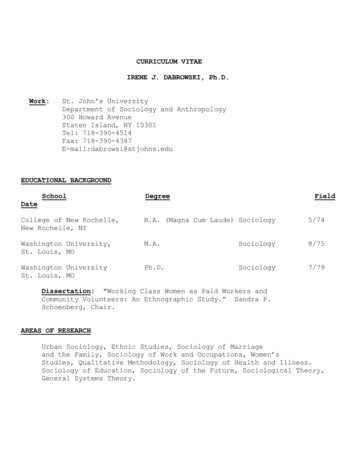
Transcription
Adaptive Learningand the Human ConditionJeffrey C. LevySeton Hall UniversityBoston Columbus Indianapolis New York San Francisco Upper Saddle River AmsterdamCape Town Dubai London Madrid Milan Munich Paris Montreal Toronto DelhiMexico City São Paulo Sydney Hong Kong Seoul Singapore Taipei TokyoA01 LEVY5479 01 SE FM.indd 18/20/12 8:25 PM
Editorial Director: Craig CampanellaEditor in Chief: Jessica MosherExecutive Editor: Susan HartmanEditorial Assistant: Shivangi RamachandranDirector of Marketing: Brandy DawsonSenior Marketing Manager: Nicole KunzmannManaging Editor: Denise ForlowProduction Project Manager: Annemarie FranklinOperations Specialist: Diane PeiranoArt Director: Jayne ConteCover Designer: Suzanne BehnkeCover Art: fotoliaMedia Editor: Peter SabatiniMedia Project Manager: Pam WeldinFull-Service Project Management: Hema LathaComposition: Integra Software Services, Ltd.Printer/Binder: Courier/WestfordCover Printer: Lehigh-Phoenix Color/HagerstownText Font: 10/12, Times LT StdCredits and acknowledgments borrowed from other sources and reproduced, with permission, in this textbookappear on page 261.Copyright 2013 Pearson Education, Inc. All rights reserved. Manufactured in the United States of America.This publication is protected by Copyright, and permission should be obtained from the publisher prior to anyprohibited reproduction, storage in a retrieval system, or transmission in any form or by any means, electronic,mechanical, photocopying, recording, or likewise.To obtain permission(s) to use material from this work, please submit a written request to Pearson Education, Inc.,Permissions Department, One Lake Street, Upper Saddle River, New Jersey 07458, or you may fax your request to201-236-3290.Library of Congress Cataloging-in-Publication DataLevy, Jeffrey C.Adaptive learning and the human condition /Jeffrey C. Levy.p. cm.Includes bibliographical references and index.ISBN-13: 978-0-205-20547-9ISBN-10: 0-205-20547-X1. Learning, Psychology of. I. Title.BF318.L48 2013153.1’526—dc23201202357710 9 8 7 6 5 4 3 2 1ISBN 10:0-205-20547-XISBN 13: 978-0-205-20547-9A01 LEVY5479 01 SE FM.indd 28/20/12 8:25 PM
To my mother, Hilda, who first taught me to love learningTo my wife, Fran, for lovingly enriching my human conditionA01 LEVY5479 01 SE FM.indd 38/20/12 8:25 PM
A01 LEVY5479 01 SE FM.indd 48/20/12 8:25 PM
ContentsPreface xiiiAcknowledgmentsxviiAbout the AuthorxviiiPART 1A Science of Adaptive LearningChapter 1 Science, Psychology,and Adaptive Learning11The Human Condition 1Explanation and Empiricism 3The Scientific Method 4Early History of Psychology 4Psychology Today 6Scientific Explanation in Psychology 7Where Does Psychology Look for Explanations? 9Human Genetic Potential 10The Importance of Learning 11Definitions of Learning 11Operational 11Structural/Functional 14Adaptive 15Direct and Indirect Learning 15Summary16 References17Chapter 2 Adaptive Learning Research Methods 18Internal and External Validity 18Nonexperimental Research Methods 19Experimental Research Methods 19Studies Comparing Groups 20Small-N Designs 21establishing the baseline 21reversal designs 22multiple baseline designs 23Adaptive Learning Research Methodsand External Validity 24Nonhumans as Subjects 24experimental apparatus 25Summary 28 ReferencesA01 LEVY5479 01 SE FM.indd 528v8/20/12 8:25 PM
viContentsPART 2 Predictive Learning29Chapter 3 Predictive Learning: Basic Principles andPhenomena 29Pavlov’s Classical Conditioning Paradigm 30Measurement Procedures 32Anticipation 32Blank Trials 33Sign Tracking 33Conditioned Suppression 35Basic Predictive Learning Phenomena 36Acquisition 37Extinction 37Spontaneous Recovery 37External Inhibition and Disinhibition 38Renewal 39Stimulus Generalization and Discrimination 40Higher-Order Conditioning and Sensory Preconditioning 40Excitatory and Inhibitory Learning 43the summation procedure 43the retardation-of-acquisition procedure 44Latent Extinction 44Occasion Setting 45Summary46 References47Chapter 4 Predictive Learning: Basic Variablesand Theoretical Issues 48Variables Influencing Predictive Learning 48Sequencing of Events 49Timing of Events—The Law of Temporal Contiguity 51eyeblink and heart rate conditioning 51an exception—acquired taste aversion 52Intensity of Events 53Scheduling of Events 54Theoretical Issues 55Is Extinction Unlearning or Inhibitory Learning? 55Pavlov’s Stimulus Substitution Model 56is temporal contiguity sufficient? 57must the cr resemble the ur? 61The Rescorla-Wagner Model 62SummaryA01 LEVY5479 01 SE FM.indd 666 References668/20/12 8:25 PM
ContentsviiChapter 5 Predictive Learning: Applications 69Basic and Applied Science 69Direct Classical Conditioning of Emotions 70Indirect Classical Conditioning of Emotions 72Desensitization and Sensitization Procedures 73Classical Conditioning of Word Meaning 74Classical Conditioning of Attitudes 75Evaluative Conditioning 77Classical Conditioning of Drug Tolerance 78Summary78PART 3 Control Learning References7881Chapter 6 Control Learning: Basic Principles andPhenomena 81Thorndike and Skinner 81Apparatuses Used to Study Control Learning 82Skinner’s Contingency Schema 84Adaptive Learning Overview 86Learned and Unlearned Appetitive and Aversive Stimuli 87Discriminative Stimuli and Warning Stimuli 89Stimulus-Response Chains 89Basic Control Learning Phenomena 90Acquisition—Appetitive Control 90Acquisition—Aversive Control 93Species-Specific Characteristics and Adaptive Learning 94Other Basic Control Learning Phenomena 95Summary95 References96Chapter 7 Control Learning: Basic Variables andTheoretical Issues 98Variables Influencing Control Learning 99Deprivation 99Timing of consequence 102positive reinforcement 102negative reinforcement—escape 102punishment 103Intensity of Consequence 104Positive reinforcement 104Positive punishment 104A01 LEVY5479 01 SE FM.indd 78/20/12 8:25 PM
viiiContentsScheduling of consequences 105Contingency Between Response and Consequence 106positive reinforcement 106negative reinforcement—learned helplessness 107Theoretical Issues 108What Maintains Avoidance Responding? 108two-factor theory 109cognitive theory of control learning 112Theoretical Explanations of the PREE 113Discrimination 113Frustration theory 113Sequential theory 115Is Punishment Effective? 115Problems of implementation 115Punishment side effects 116Desirability of reinforcing an alternative response 118Summary 119 References 120Chapter 8 Control Learning: Applications 122Speech and Language (Verbal Symbolic Behavior) 123Parenting 124Parenting Styles and Control Learning 124Parenting Styles and Moral Development 126Preparing for Adulthood 127preparing children to Be hunter/gatherers 127preparing children for school and work 128Treating Behavioral Problems with NonverbalIndividuals 130Applied Behavior Analysis with Autistic Children 130behavioral excesses—reducing self-injurious behavior 131behavioral deficits—establishing imitation and speech 132Treating Behavioral Problems with Verbal Individuals 133Cognitive-Behavioral Treatment of Depression 133Contingency Management of Substance Abuse 134Empirically Validated Therapeutic Techniques 134Using Technology to Treat Behavioral Excesses 135Relapse Prevention 137SummaryA01 LEVY5479 01 SE FM.indd 8138 References1388/20/12 8:25 PM
ContentsixChapter 9 Schedules of Reward and Maintenanceof Learned Behavior 142Skinnerian Methodology 143The Operant Chamber (Skinner-Box) 143Cumulative Records 143Skinner’s Schema of Intermittent Schedules ofReinforcement 146Why Do Ratio Schedules Produce Higher Response Rates ThanInterval Schedules? 149Maintenance of Learned Behavior 150Differential Reinforcement Schedules as Alternatives toPunishment 151Extinction as an Alternative to Punishment 152Noncontingent Reinforcement as an Alternative toPunishment 153Summary153 ReferencesPART 4 The Human Condition154155Chapter 10 Personality, Socialization, andCulture 155Multiple Schedules, Personality, and Culture 155Stimulus Control, Baseball, and the Human Condition 157Measuring Stimulus Control in the Laboratory 160Determinants of Stimulus Control Test Patterns 162The Peak Shift and Spence’s Model of DiscriminationLearning 163Attention Theory and Discrimination Learning 165Summary168 References169Chapter 11 Becoming Human and Transforming theHuman Condition 170Concept Learning 170Qualitative and Quantitative Concepts 171Natural Concepts 172Learning to Learn 174Basic Research in Problem Solving 175Facilitative Effects of Prior Experience 176Interference Effects of Prior Experience 177A01 LEVY5479 01 SE FM.indd 98/20/12 8:25 PM
xContentsThe General Problem-Solving Process 179Tools, Technology, and the Human Condition 180The Law of Accelerating Returns 180the stone age, bronze age, and iron age 180the industrial revolution and the modern era 181The Phonetic Alphabet and Arabic Numbering System 186Summary187 References188Chapter 12 Becoming Human Through Indirect SocialLearning 189Bandura’s Four-Stage Model of Observational Learning 190Attention 190Retention 191Response capability 192Motivation 192Speech and Language 194Hockett’s Features of Language 194Language Acquisition 195Preparing for School and the 3 Rs 196Summary198 References199Chapter 13 Adaptive Learning andSelf-Actualization 201The Nukak’s Physiological Needs 202Hunting and Gathering 202The Nukak’s Shelter and Safety Needs 206Building a Campsite 206The Nukak’s Love and Interpersonal Needs 208The Nukak’s Esteem Needs 209The Nukak’s Self-Actualization Needs 210Our Physiological Needs in Comparison to the Nukak’s 211Our Shelter and Safety Needs in Comparison to theNukak’s 211Our Love and Interpersonal Needs in Comparison to theNukak’s 212Developmental Tasks and Stages for the Nukak and Us 213Our Esteem Needs in Comparison to the Nukak’s 214Our Self-Actualization Needs in Comparison to theNukak’s 215Bridges, Globalization, and the Human Condition 215SummaryA01 LEVY5479 01 SE FM.indd 10216 References2178/20/12 8:25 PM
ContentsxiChapter 14 Self-Actualization ThroughSelf-Control 218Concurrent Schedules and the Matching Law 219Self-Control—Magnitude and Delay of Reinforcement 221Commitment 221The Marshmallow Test 222Matching, Impulsiveness, and Adaptive Learning 223Determinism and Freedom 225Lightning, Sharks, and Human Predators 226Will Power and Self-Control 227Self-Control as Problem Solving 228Defining and Measuring the Problem 228Collecting Baseline and Intervention Data 229Manipulating as and Cs to Affect Bs 230Improving the Human Condition Through HumanisticEcology 231Summary232 References232Glossary 235References245Credits 261Index262A01 LEVY5479 01 SE FM.indd 118/20/12 8:25 PM
A01 LEVY5479 01 SE FM.indd 128/20/12 8:25 PM
PrefaceThe systematic study of adaptive learning has a long and storied history dating back tothe beginning of the 20th century. At that time, Ivan Pavlov and Edward Thorndike introduced the two major experimental paradigms of classical and instrumental conditioningthat have since defined this research area and stood the test of time. In the 1930s, B. F.Skinner made significant contributions to the study of instrumental conditioning. Themethods and technical vocabularies he and Pavlov developed still serve as the basis oforganizing the content covered in chapters and textbooks of learning.Historically, there have been two major categories of learning textbooks: thoseemphasizing theories, exemplified by Hilgard and Bauer’s Theories of Learning (1975),and those emphasizing principles, exemplified by Kimble’s revision of Hilgard andMarquis’s Conditioning and Learning (1961). The present book is in the tradition ofthe latter and similar in coverage to recent texts in learning and behavior (e.g., Domjan,2009; Mazur, 2006; Powell, Symbaluk, & Macdonald, 2009; Schwartz, Wasserman, &Robbins, 2002).Similar to other learning textbooks, Adaptive Learning and the Human Conditionemphasizes the experimental research literatures related to classical and instrumentalconditioning. Defining learning as an adaptive process through which individuals acquirethe ability to predict and control the environment enables the student to appreciate whythese two research paradigms, and only these two, are addressed. Adaptation requiresacquiring the ability to predict, and when possible, control environmental events. Pavlovstudied animals under circumstances that made it possible to predict, but not control,events. Thorndike and Skinner studied animals under circumstances in which their behavior reliably impacted (i.e., controlled) the environment. Observational learning andlanguage are treated as indirect processes for acquiring the same abilities. This enablesstudents to appreciate the relevance of the animal learning literature to human beings aswell as the ubiquity and importance of learning principles in our everyday lives.The first and last chapters of Adaptive Learning and the Human Condition beginwith the same sentence. A recurring message of this book is that learning principlesconstitute very powerful explanations for human behavior and help us understand theway we live and why we, more than any other animal, dominate this planet. The twomost fundamental ways in which this book differs from other learning textbooks arereflected in the title and this sentence. Learning is defined as an adaptive process thatwhen combined with the human capacities for speech and creation of tools has enabledus to transform the world and thus the human condition. In addition to the usual extension of learning principles to clinical applications, they are related to such nontraditionaltopics as parenting, moral development, schooling, the effects of technology, and humanself-actualization.The “Big Map”A textbook, like a course, may be described as a long journey (Levy, 1991). When writing a textbook or teaching a course, it is essential to be an effective guide and to provideuseful maps. Before starting, it is often helpful to look at the “big map” portraying thexiiiA01 LEVY5479 01 SE FM.indd 138/20/12 8:25 PM
xivPrefaceentire length of the journey. This provides a sense of the scope, as well as an appreciationfor where separate trips fit within the overall travel plan. Here and there we may find itnecessary and/or enjoyable to take a short side trip. I hope you enjoy the ride!The textbook (journey) is divided into four major sections (trips): Introduction tothe Science of Adaptive Learning (Chapters 1–2), Predictive Learning (Chapters 3–5),Control Learning (Chapters 6–9), and The Human Condition (Chapters 10–14).Chapter 1 considers how the assumptions, strengths, and limitations of the scientific method apply to the discipline of psychology. The goals and methods of theearly schools are described as we examine how current approaches to the disciplineevolved. Psychology studies how hereditary (nature) and environmental (nurture) variables affect the thoughts, feelings, and actions of individuals. Learning is seen asa ubiquitous p rocess throughout the animal kingdom, whereby individuals change asthe result of experience. It is adaptive, enabling individuals to predict and control their circumstances. The traditional classical and instrumental (or operant) conditioning p aradigms, i ntroduced by Pavlov, Thorndike, and Skinner, relate to these two components of adaptation. Classical conditioning procedures study individuals underconditions that enable them to predict, but not control, their environment. Instrumentalconditioning procedures study i ndividuals under conditions that enable them to affectthe environment. Observational learning and symbolic communication (i.e., language)are treated as indirect procedures for acquiring the ability to predict and control.The title of the book implies that a science of adaptive learning can result in principles helpful to understanding and influencing the human condition. Chapter 2 addressesthe needs of a science to determine cause and effect (internal validity) under naturalisticconditions (external validity). Issues concerning the implementation of these strategiesto the study of psychology are considered. The strengths of large-N and small-N experimental designs in addressing internal validity concerns are described. Issues related tothe extension of findings obtained with other animals studied in specialized apparatusesto the human condition are considered.Chapters 3 through 5 consider the scientific research findings related to predictivelearning. Basic principles, phenomena, theoretical issues, and applications are reviewed.Chapters 6 through 8 cover the same topics for control learning. Chapter 9 describesissues related to the maintenance of learned behavior. Alternatives to punishment as aprocedure to reduce problematic behaviors are considered. A unifying schema for adaptive learning is presented, consisting of the ability to predict and control the occurrenceor nonoccurrence of appetitive and aversive events. In subsequent chapters, this schemais used to describe and explain the changing human condition and to generate solutionsto individual and social problems.Chapter 10 describes how adaptive learning principles may be applied to understandhuman personality and culture. Chapter 11 extends adaptive learning principles to conceptlearning, problem solving, and tool making. The abilities to learn, communicate symbolically, and use the precision grip have enabled humans to create transformational technologies. Chapter 12 describes how reading and writing enable the permanent recordingof human advancement, further accelerating the transformational process. In Chapter 13,Maslow’s hierarchy of human needs is used to compare the human conditions for contemporary Stone Age hunter/gatherers and technology-enhanced cultures. Chapter 14addresses the implications of a science of adaptive learning to issues of freedom andA01 LEVY5479 01 SE FM.indd 148/20/12 8:25 PM
Prefacexvdeterminism. Self-control strategies are described as alternatives to relying upon willpower to achieve personal goals and to self-actualize.The topic of learning poses many challenges for a textbook author. The materialis difficult to “chunk” into meaningful units telling a story. One must define what constitutes “the forest and the trees” in selecting articles to cite from the extensive classicand current research literature. The title of the book implies the strategies used to addresseach of these challenges.The four book sections constitute the major chunks:1. The study of learning is placed within the context of the scientific revolution originating around the time of Galileo; learning is defined as an adaptive process throughwhich individuals acquire the ability to predict and control the environment.2. Predictive learning (classical conditioning) methods, principles, theoretical issues,and applications are treated in depth.3. Control learning (instrumental conditioning) methods, principles, theoretical issues, and applications are treated in depth.4. Adaptive learning principles are applied to the understanding of the humancondition.Throughout the book, research is selected from the voluminous nonhuman literature withan eye toward application to understanding and addressing human concerns. Often, thelives of members of a Stone Age nomadic tribe (the Nukak) are contrasted with thoseof humans in technologically enhanced societies so that the student can appreciate theremarkable transformation that has taken place over the eons, centuries, and even withintheir lifetimes. Toward the end of the book, the principles are applied to help us understand the accelerating transformation of our planet and the human condition. In the finalchapter, the student is asked to consider the implications and applications of learningprinciples to governing their own lives. The topics of freedom and self-control are considered in both theoretical and practical terms.Little Maps and Student Learning AidsI have tried to write Adaptive Learning and the Human Condition in a clear, engagingstyle for the undergraduate student. A few learning aids have been integrated into thetext in order to help students acquire an often unfamiliar and technical vocabulary and tounderstand the material in a more cohesive and integrative way than is assessed throughobjective examination questions (i.e., multiple choice and true-false).The four major sections constitute the big map, charting the entire journey. Chapteroutlines at the beginning constitute small maps, providing the detail necessary to considerand negotiate current journeys. Even though summaries occur at the end of chapters, itwould be an effective strategy to read them and consider how they relate to the outlinesbefore actually beginning the content. The summaries are partially written in a cumulative manner. Rereading them after completing the chapters should enable the student tointegrate the current material with that covered previously as the story line progresses.Key terms are highlighted and defined in the margins near where they firstappear as well as in a comprehensive glossary at the end of the book. Students oftenbelieve that studying simply consists of reading and rereading the material. I encourageA01 LEVY5479 01 SE FM.indd 158/20/12 8:25 PM
xviPrefacea more active approach in which students ask themselves and try to answer questionsrequiring mastery of the factual and conceptual material. I try to assist them in becoming objective and accurate assessors of their own learning. Comprehensive essay questions are provided at the end of major sections. I suggest that students assess theirmastery of the material by either standing in front of a mirror and stating the answersout loud or writing them down. The questions are difficult, and it is unlikely that thestudent will be able to adequately answer them by attempting to memorize the material. A thorough understanding of the rationale and details regarding the procedures,findings, and implications of the research literature is required.I have attempted to present the material in a sufficiently interesting way so that thestudent recognizes its relevance and importance and becomes willing to dedicate the timeand effort required to achieve a high level of mastery. From the time I was an undergraduate and fell in love with psychology, I have believed and hoped that application of thescientific method to the study of behavior could help us frame human existential issuesas testable questions and develop effective technologies to address individual and socialconcerns. By writing this book, I have attempted to share this belief and hope with others.A01 LEVY5479 01 SE FM.indd 168/20/12 8:25 PM
AcknowledgmentsMy interest in learning principles dates back to my memorable experience in EdwardGavurin’s undergraduate course at Hunter College, City University of New York. Thisinterest was nurtured in the stimulating and inspirational classes and office conversations held during my graduate studies with Jeffrey Landau and Coleman Paul at AdelphiUniversity.My Seton Hall departmental colleague Michael Vigorito provided valuable feedback on sections of this book and was enormously helpful in the creation of many ofthe graphs and tables. I owe thanks to Provost Gabriel Esteban and Vice Provost LarryRobinson for making me an offer I couldn’t refuse and granting me a sabbatical year towork on the book. In addition to providing her usual encouragement and support as mywife and soul mate, Fran added muse and editor to her lengthy job description. This bookis dedicated to Fran and my mother, Hilda Levy, who first taught me to love learning.Finally, I would like to thank all those at Pearson who made the editing and production process so constructive, efficient, and enjoyable.I would also like to extend my thanks to the following individuals who reviewedmy manuscript and provided many thoughtful and helpful comments and suggestions:David Rentler—University of the Rockies, Margherita Rossi—Broome CommunityCollege, Jeffrey Lamoureux—Boston College, Yosh Kawahara—San Diego MesaCollege, Xiongyi Liu—Cleveland State University, Robert Boughner—Rogers StateUniversity, W. David Stahlman—UCLA, Kimberly Hall-Chambers—ClevelandState University, James Crosby—Sam Houston State University, Jonathan Kahane—Springfield College, and Peter Spiegel—California State University, San Bernardino.Jeffrey C. LevySouth Orange, New JerseyxviiA01 LEVY5479 01 SE FM.indd 178/20/12 8:25 PM
about the authorJeffrey C. Levy’s professional career at Seton Hall University maybe divided into three stages, BC, DC, and AC (before, during, andafter his 24-year term as chair of the Department of Psychology).Frequently recognized for teaching excellence, he received the DeansAdvisory Council’s Outstanding Teacher Award for the College ofArts & Sciences and the Sears-Roebuck Award for College Teachingand Campus Leadership, and he was twice nominated by Seton Hallfor National CASE Professor of the Year recognition. Trained as anexperimental psychologist with interests in behavior modification,Levy regularly taught the undergraduate Learning course with andwithout a related animal laboratory and a graduate course in BehaviorModification. A sabbatical opportunity subsequent to his service aschair enabled him to dedicate a year to elaborating upon this teachingexperience and drafting Adaptive Learning and the Human Condition.xviiiA01 LEVY5479 01 SE FM.indd 188/20/12 8:25 PM
Seton Hall University . To obtain permission(s) to use material from this work, please submit a written request to Pearson Education, Inc., Permissions Department, One Lake Street, Upper Saddle River, New Jersey 07458, or you may fax your request to . Chapter 12 BeCoMing huMAn ThRough indiReCT SoCiAL LeARning 189 Bandura's Four-Stage .


